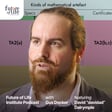Become a Creator today!Start creating today - Share your story with the world!
Start for free
00:00:00
00:00:01

Not Cool Ep 23: Brian Toon on nuclear winter: the other climate change
Though climate change and global warming are often used synonymously, there’s a different kind of climate change that also deserves attention: nuclear winter. A period of extreme global cooling that would likely follow a major nuclear exchange, nuclear winter is as of now — unlike global warming — still avoidable. But as Cold War era treaties break down and new nations gain nuclear capabilities, it's essential that we understand the potential climate impacts of nuclear war. On Not Cool Episode 23, Ariel talks to Brian Toon, one of the five authors of the 1983 paper that first outlined the concept of nuclear winter. Brian discusses the global tensions that could lead to a nuclear exchange, the process by which such an exchange would drastically reduce the temperature of the planet, and the implications of this kind of drastic temperature drop for humanity. He also explains how nuclear weapons have evolved since their invention, why our nuclear arsenal doesn't need an upgrade, and why modern building materials would make nuclear winter worse.
Topics discussed include:
-Causes and impacts of nuclear winter
-History of nuclear weapons development
-History of disarmament
-Current nuclear arsenals
-Mutually assured destruction
-Fires and climate
-Greenhouse gases vs. aerosols
-Black carbon and plastics
-India/Pakistan tensions
-US/Russia tensions
-Unknowns
-Global food storage and shortages
For more:
https://futureoflife.org/2016/10/31/nuclear-winter-robock-toon-podcast/
https://futureoflife.org/2017/04/27/climate-change-podcast-toon-trenberth/
Transcript
The Ferocity of City Fires and Climate Implications
00:00:00
Speaker
What happens when you set a city on fire is you create this immense area that's on fire all at once. The wind comes rushing in from all directions and you get winds that are like hurricane force winds blowing into the fire. So you get this ferocious wind and you get a smoke plume that goes very high.
Introduction to the Threat of Nuclear Winter
00:00:19
Speaker
Hi everyone, Arielle Kahn here with episode 23 of Not Cool, a climate podcast. As I suspect most of you know, at the Future of Life Institute, our focus is on mitigating existential threats. As such, global warming is not the only climate change threat we worry about, and it didn't seem right to do an entire podcast series on climate change without also considering the other major and catastrophic climate threat that could destroy much of life on Earth.
00:00:48
Speaker
nuclear winter. We'll get into this more in the podcast, but nuclear winter is essentially the theory that if we had a major nuclear war, so much smoke and debris would get lofted high into the atmosphere, blocking the sun and dropping temperatures by as much as 20 degrees Celsius in many parts of the world.
Origin and Influence of Nuclear Winter Theory
00:01:07
Speaker
This theory was first presented in 1983 in what would later become known as the TAPS paper, where TAPS is the acronym of the authors, Brian Toon, Rich Turko, Tom Ackerman, James Pollack, and Carl Sagan. And this theory was one of the factors that led the US and Russia to reduce their nuclear stockpiles.
00:01:28
Speaker
I'm thrilled to have one of those authors, Brian Toon, on the show today. In addition to having studied nuclear winter for over 30 years, Brian Toon is also a professor at the University of Colorado at Boulder in the Department of Atmospheric and Oceanic Sciences, for which he was the founding chair, and he's a research associate in the Laboratory for Atmospheric and Space Physics.
00:01:48
Speaker
His research group studies radiative transfer, aerosol and cloud physics, atmospheric chemistry, and parallels between the Earth and planets. Brian helped conceive, develop, and lead many NASA airborne field missions aimed at understanding stratospheric volcanic clouds, stratospheric ozone loss, the effects of aircraft on the atmosphere, and the role of convective and cirrus clouds in Earth's climate system.
00:02:14
Speaker
He has been involved in numerous satellite missions for both Earth and the planets. He's published more than 300 papers in refereed scientific journals and is one of the most highly cited researchers in geoscience. Brian, thank you so much for joining us today. Well, thank you for inviting me.
How Nuclear Winter Affects the Planet
00:02:32
Speaker
Just as a reminder for listeners, can you tell us what nuclear winter is? Nuclear winter is the idea that
00:02:40
Speaker
Following a nuclear war, the explosions of high energy weapons in cities would start fires in the cities. And those fires would send smoke to high altitudes where it would stay for years and block sunlight from reaching the ground all across the globe. And as a consequence of that, it would get cold at the ground because there wouldn't be as much sunlight reaching the ground. And it would also get very hot in the stratosphere because of all the light that's being absorbed up there, which would destroy the ozone layer.
00:03:10
Speaker
And so you have a combination of the laws of the ozone layer, which protects us from harmful ultraviolet radiation at the ground and it being cold at the ground. And there's a whole range of effects that you can have depending on how big of a war you have.
00:03:26
Speaker
So to have a real nuclear winter, which means that the temperatures at mid latitudes in grain growing regions like Iowa or Ukraine are below freezing every day for several years, that would be a real nuclear winter.
Potential Consequences of Smaller Nuclear Conflicts
00:03:42
Speaker
But you might have a smaller war between India and Pakistan, for example, and that might still cause it to be cool at the ground, but it wouldn't be below freezing all the time. That would not be a nuclear winter, but it might still be devastating to agriculture.
00:03:57
Speaker
You were one of the original people to start looking into this idea of nuclear winter. Can you talk a little bit as well about sort of the background behind this theory? Well, there were several people involved in this and most of us came into this problem by way of the extinction of the dinosaurs. So we had been working on problems about supersonic aircraft polluting the atmosphere and volcanoes and how volcanic clouds might alter the climate.
00:04:26
Speaker
These were early days in climate modeling, so people were interested to know those issues. And then in 1982, a group of people at Berkeley discovered that an asteroid had hit the Earth at the time of the extinction of the dinosaurs.
Historical Research and Government Influence
00:04:40
Speaker
And we started working on that problem.
00:04:42
Speaker
We now know that the extinction occurred because everything on the surface of the Earth caught fire and because of the asteroid curling material into the upper atmosphere so that the entire Earth was covered in what looked like to us a sheet of glowing hot lava. If you happen to be there, you'd feel like you were inside your oven with it turned on broil, which would be very unpleasant.
00:05:05
Speaker
At any rate, while we were working on that, someone asked us what would happen if there was a nuclear war. And we hadn't actually thought about this problem a year or so earlier, and we hadn't really thought of any terrible environmental effects that would affect everybody on the planet. Obviously, if you're in a city with a nuclear explosion, it would be very bad, but nothing global. But when we were asked to think about this again, we started to work on it.
00:05:30
Speaker
And we first thought about dust being lifted by the explosions, but then it was pointed out by Paul Crutzen, who's a Nobel prize-winning chemist, that there would be a lot of fires, producing a lot of smoke, which actually was an idea he'd gotten from someone else who'd written a paper about a scientific American. So then we began to investigate the smoke, and it was very obvious, even with a modest amount of smoke, that the sun's intensity would be greatly diminished, and it would get very cold at the ground.
00:05:58
Speaker
and the temperatures would actually stay below freezing for a long period of time. So this was all discovered in about 1983, and it was very controversial at the time. Huge numbers of people worked on it, although they were forbidden to work on it by most of the government agencies.
00:06:17
Speaker
So, for example, NASA only allowed our little group to work on it and actually stopped other people from studying fires. NOAA forbid any scientists in its organization to work on this problem, which is unfortunate because they had a lot of climate models. The National Science Foundation wouldn't let anybody work on it, but two people at the National Center for Atmospheric Research
00:06:38
Speaker
So this was a problem really in the long run because basically all the scientists in the world who might have wanted to work on this, which would be the normal response of scientists. If some hot new problem comes up, everybody leaps in to try to work on it and that they were prevented from working on
Political Recognition and Reduction of Nuclear Arsenals
00:06:54
Speaker
it. And really only a group of scientists from the Department of Energy, which is the agency of the government that builds nuclear weapons, were really allowed to work on it.
00:07:03
Speaker
There was a brief period of time for a year or two when Congress required the Department of Defense to fund a bigger program. And so there was actually a huge amount of work done then by a broad range of scientists in the United States. But that funding didn't last about two or three years. So people did a lot of work on it. The US National Academy of Sciences had a panel look on it and look at the problem. And they concluded that what we had said was plausible and they couldn't think of any issues with it at that time.
00:07:32
Speaker
A few years later, there was a study by the Scientific Committee on Problems of the Environment, which is a United Nations committee that involves all the Academy of Sciences in the world. And they wrote two books about the subject and likewise couldn't find anything wrong with it at that time.
00:07:49
Speaker
And in fact, nothing has been found wrong with this theory so far after several decades of people looking at it, although there are scientific issues in here that need to be studied further and one could find problems with it. So there are definitely issues left to understand better.
00:08:06
Speaker
And since that time, of course, the politicians learned about these problems with the nuclear war. And in about 1986, Ronald Reagan and Mikhail Gorbachev, who were then the presidents of the United States and the Soviet Union, decided that it was immoral for the world to have these big arsenals, which might destroy civilization.
00:08:28
Speaker
They actually both said that they understood the science behind this problem and that it wasn't the right thing for people to do. Ronald Reagan gave interviews to the New York Times in which he described how the nuclear winter worked and how dangerous it would be and that it was unacceptable. Gorbachev said similar things and they both said we have to reduce nuclear arsenals.
00:08:51
Speaker
And they did start reducing nuclear arsenals in every American president and every Russian president since that time has reduced nuclear arsenals. So in 1986, we had 70,000 nuclear weapons on the planet. Now we have about 14,000 nuclear
Minimal Weapons, Maximum Impact
00:09:09
Speaker
weapons. We still have a lot. How many nuclear weapons do you estimate would be required to trigger nuclear winter or a cooling at all? Very few.
00:09:21
Speaker
So right now, the United States has about 300 cities that have more than 100,000 people. Russia has about 200 cities with more than 100,000 people. So we could destroy all of Russia's moderate-sized towns and cities with around 200 nuclear weapons. If you think some of them might not work, okay, maybe you would need 400 nuclear weapons assuming half of them failed, although most people don't think the failure rate would be anywhere near that big.
00:09:51
Speaker
And Russia could destroy the United States with 300 weapons. So the number of weapons you need to destroy the other country is not very large. And you don't even need that many weapons to cause a nuclear winter. We think you could probably do it with a hundred weapons in large urban areas. I want to come back to that. But before I get to that question, I want to go back to something else you were saying earlier, where you were saying there were still more scientific questions to
Global Risks and Tensions in Nuclear Warfare
00:10:16
Speaker
answer. What are some of those?
00:10:18
Speaker
Okay, well, there's a whole chain of calculations you have to do to determine how cold it might be at the surface. And if you want to know how many people would be killed by the initial blast, there's a much shorter number of calculations you have to do. So the first thing you have to know is what's the target.
00:10:37
Speaker
You know, are they going to aim missiles at other missiles? For example, in Colorado here, there are about 400 missiles spread from here up through Wyoming and Montana in about 50 miles from where we're sitting near Fort Collins. There's about 50 in the ground.
00:10:56
Speaker
And those might be targets for Russian missiles that would want to keep those missiles from being launched. So they might explode 100 nuclear weapons up near Fort Collins in Cheyenne, Wyoming, which is mostly a grassy area. So not many people would be killed there. There's not much fuel there.
00:11:14
Speaker
The main danger from those would be the radiation that would be produced by the weapons, which could spread out for hundreds of miles downwind and produce a lethal dose to anybody who was exposed over the next few days. The targets that are of most concern are cities, and that's what nuclear weapons were built to do. They were built to destroy cities. That's the lesson from the Second World War.
00:11:38
Speaker
In the Second World War, the United States originally tried to win the war by bombing military facilities with small bombs that were guided by Norden bomb sites. And despite all the propaganda about that, those bomb sites never worked very well. They were never able to hit their targets very well. And so in the last few years of the war, the United States and Britain would send hundreds of airplanes
00:12:02
Speaker
over German or Japanese cities. And instead of dropping explosive weapons, they would drop incendiary bombs, which were small things about the size of a brick. And their goal was to hit the roof of the building, make a hole in the roof, and fall down into the building and start it on fire. They started immense fires in German cities, such as Dresden and Hamburg. In Japan, we burned 69 cities to the ground with great fleets of aircraft.
00:12:31
Speaker
Now, of course, if you send 500 airplanes over a city, some of them are going to get shot down, some of them are going to have problems just flying there. So the advantage of a nuclear weapon is you don't need 500 airplanes, you just need one. You only need one bomb and you can burn a whole city to the ground.
00:12:49
Speaker
So in the Second World War, Tokyo was burned to the ground by incendiary bombs and killed more people than the Hiroshima bomb did. But there was only one bomb in Hiroshima. So despite what the Department of Defense wants to pretend that they're going to use these weapons on military targets, they were built to bomb cities and destroy huge urban areas, mostly by burning them to the ground.
00:13:14
Speaker
So the first issue is just what's the target. If it's an urban area, you want to know how much fuel is there to burn. Wooden buildings like houses people live in, petroleum and refineries, perhaps coal stored at a power plant. There's some trees around. You know, there's lots of things to burn in cities. But this is a problem. It's hard to tell for sure how much fuel is in a particular city, especially in a city in India or Pakistan, which may be different.
00:13:42
Speaker
than a city in the United States or Europe in terms of what they build their buildings out of. And it's also that we don't have experience with whole cities burning. So we really don't know what those fires are like except for the experience in Hamburg and Dresden and Hiroshima.
00:13:57
Speaker
I want to ask about that because the theory of nuclear winter is based off smoke and soot and whatever else going up into the atmosphere and blocking the sun. But how is that different from the firestorms and fires that ravaged the cities in World War II? It's probably very similar. Hamburg, the area that was burned there, was about 13 square kilometers. And the area in Hiroshima that destroyed by fire was also about 13 square kilometers.
00:14:26
Speaker
It's interesting that, although we think of the energy in this explosion, the bomb in Hiroshima had the explosive power of 15,000 tons of the conventional explosion. But the fire, these fires are very energetic. There was probably a thousand times as much energy released in the fire in Hiroshima than was released by the bomb.
00:14:48
Speaker
So these fires are something that, you know, they do happen in natural circumstances. For example, San Francisco, when it had its earthquake in 1906, the real damage there was not done by the earthquake. It was done by a fire that was partly set by the earthquake and partly set by people trying to fight the fire by setting backfires. And this whole thing was described by Jack London, the famous author in Oakland at the time and across the Bay from San Francisco.
00:15:15
Speaker
And that was the largest maritime evacuation in American history. All kinds of boats from Oakland and Alameda went across the bay and rescued people who were trapped on the shore in San Francisco by the fire. And he describes this fire as the winds. There were no winds in Oakland, but there was a ferocious wind in San Francisco, a great tower of smoke coming up. So what happens when you set a city on fire is you just create this immense area that's on fire all at once.
00:15:45
Speaker
People will see forest fires where the wind is going in one direction and pushing the fire. But in these big firestorms, the wind comes rushing in from all directions. So it makes the fire burn much more energetically. It's like blowing on a fire in your fireplace or something. It makes it burn faster. And you get winds that are like hurricane forest winds blowing into the fire.
00:16:07
Speaker
people in Dresden and Hamburg described clothes being ripped off of people and people being blown into the interior of the fire by the wind. So you get this ferocious wind and you get a smoke plume that goes very high. We see occasionally that there are forest fires that do this. There was one in 2018 in Canada that created a smoke plume that went into the stratosphere.
00:16:30
Speaker
and we could see the smoke from satellites for about eight months. So that's the second place where there's a lot of uncertainty. The first question is how much fuel is there to burn and how intense is the fire and does it sit in one place or blow in the wind? But the second thing is how high does the smoke get? In those examples that you just gave, did we see cooling effects at all?
00:16:54
Speaker
Well, for example, Hamburg, we know that the smoke plume there got as high as eight kilometers. So we know the smoke did go very high and the Germans were very methodical there. They went out and analyzed the place it burned and they computed amount of fuel that was there. So they actually told us what the amount of fuel was and we know how high the smoke went. So that was three interesting data.
00:17:16
Speaker
But, you know, most of these fires happened over about two years. So there was a long period of these fires being set by incendiary weapons, and it was in the middle of a war. So there wasn't much scientific measurement going on. So we have no record of how much smoke got into the upper atmosphere. People would have not really been able to measure it at the time anyway. They didn't have satellites and advanced instruments.
00:17:42
Speaker
Alan Roebuck has looked at the data in the Second World War and there was a slight cooling right after the war, which could have been caused by smoke from these burning cities. But we just don't know how much smoke was produced and the evidence for the amount of smoke in the atmosphere is limited. So yes, it did cool off a little bit apparently, but it's hard to be certain if that was just due to some natural fluctuation in the weather or whether it was caused by these fires.
00:18:11
Speaker
So then when we're looking at your research, you're clearly expecting that if we have a real nuclear war, something different will be happening. And is that that a fire in a single city would be much bigger? Is it that there would be more cities on fire, all of the above?
00:18:26
Speaker
all of the above, because there are 14,000 nuclear weapons out there. So you could attack basically every city of any size in Europe and Russia and the United States, plus other places which aren't even cities like missile fields. So you'd have potentially all of Europe and the United States and possibly China on fire, and the size of
00:18:46
Speaker
Modern nuclear weapons is much larger than the one in Hiroshima, so it was a 15 kiloton explosion, which means it was explosive power of 15,000 tons of conventional explosive. But now the typical sized weapon in the American and Russian arsenals and the European arsenals is probably around 300,000 tons, 20 times more powerful than the Hiroshima bomb.
00:19:13
Speaker
And there are some bombs that are much bigger than that. Even a single Trident missile carrying submarine, the United States has always got four of these at least deployed and has 18 of them. Russia has similar kinds of submarines. A single American submarine is capable of carrying 200 nuclear weapons because of the treaty regulations, which were in effect until the Trump administration has walked away from them.
00:19:41
Speaker
restricted the number of missiles on a single submarine to about 100. But even that way, an American submarine with 100 Trident missiles, each one of those, the smallest one is a 100 kiloton weapon, could destroy an entire city instead of just a little fraction of it like the one that fell on Hiroshima. So for example, if a 100 kiloton weapon blew up over Denver,
00:20:05
Speaker
It would start fires within a circle of six miles in diameter. So if you dropped it on the city center, the fire would go all the way out of the zoo. So the weapons are much bigger and there are many more of them than the fires that were started in the Second World War. You've done a lot of work looking, especially at India and Pakistan, but also the US and Russia. And I was wondering if you could just talk about the differences between if India and Pakistan were to get into an all-out nuclear war versus the US and Russia.
00:20:35
Speaker
The US and Russia between them have each got about 4,000 strategic nuclear weapons. So this is kind of a game that politicians have been playing with us for about 20 years. It used to be before 2000, we counted all the weapons. So Russia has all kinds of what are called tactical weapons that are used for fighting a battle in Europe.
00:20:56
Speaker
to blow up tanks or something. But that's really misleading because those weapons have great explosive yields, bigger than the Hiroshima bomb, and they're not going to get counted. The ones we count are called strategic weapons, which means they're not used to fight a battle against soldiers and tanks. They're shot off on missiles to attack long-range targets in Russia or the U.S.
00:21:18
Speaker
And there are about 4,000 nuclear weapons that are capably put on those missiles. But in another political dodge, only 2,000 of those are counted on each side because those are the ones that are actually on a missile and deployed. The other ones are just sitting in storage somewhere, which, of course, in the event of a war could potentially be brought out and used. There's a lot of missiles there between Russia and the United States that are very powerful.
00:21:45
Speaker
Now, in the early 2000s, Pakistan and India had several skirmishes. They nearly went to war with each other. They've had four wars since they separated from Britain following the Second World War when they became independent.
00:22:01
Speaker
They each had tested nuclear weapons in 1998, but not since then. So the reason I became interested in them was because during one of these wars, a reporter called me up and said, well, what would happen if there was a nuclear war between India and Pakistan, which they were threatening each other with? And I said, well, I didn't know. I hadn't thought about it. A lot of Indians and Pakistanis would get killed, but it probably wouldn't affect the rest of the world.
00:22:25
Speaker
And this was the usual response to a reporter who says, you have to write an article in the next six hours, answer this question immediately. So you're not expecting this question.
00:22:36
Speaker
So I felt guilty about that and I decided I better go look up how many weapons they had. It took me a couple of years to figure out how many weapons India and Pakistan had and how big they might be and where they would likely use them. And I was very surprised to discover that at that time they each probably had about 50 nuclear weapons, probably about the same size as the one that was used on Hiroshima, probably the same type of design of weapon. And I calculated how much smoke I thought they were produced.
00:23:06
Speaker
So I was working with Rich Turko then, who had originally worked on the nuclear winter problem. And he and I tracked down Alan Roebuck, who we knew could calculate the effects of the carbon better than we could at that moment. He said, well, I don't think anything will happen, but yeah, I'll go do a calculation. And he was surprised to learn that, yes, actually a severe climate change bigger than anything that had happened on the planet since the end of the last ice age would occur.
00:23:32
Speaker
So this situation has only gotten worse because India and Pakistan are building up their arsenals at a rapid pace. They each now have about 150 and it's expected if they keep up on this path.
00:23:45
Speaker
that by 2025, Pakistan will be the third largest nuclear power on the planet by the number of weapons they possess. They'll probably have about 250 then, so it would be the United States, Russia, which are about to equal, and then Pakistan and India probably right behind would be the major nuclear powers on the planet. Sorry, real quick, how many weapons does China have? France, Britain, China, each have some number that's around 200 nuclear weapons.
00:24:15
Speaker
OK. And it's not actually easy to tell how many weapons these countries have, because unlike Russia and the United States, which have treaties that require exposing the numbers of weapons they have or information for which you can learn that, the other countries aren't required to do that. The way you determine the size of their arsenals is partly to look at the amount of material they're producing for which they can make bombs, which is enriched uranium. So you hear about Iran producing enriched uranium.
00:24:45
Speaker
or it's plutonium, which can make it a nuclear reactor. But a better way of doing it is to count the number of weapon systems they have that can deliver nuclear weapons. Pakistan and India both have cruise missile programs. They both have nuclear capable aircraft, mostly that have come from the United States or Russia or France. India has a nuclear powered submarine that it wants to use to launch nuclear missiles with. It has missile launching ships
00:25:14
Speaker
Pakistan's building submarines and also wants to have a nuclear navy. Both of these countries have advanced missile systems and aircraft systems and other things to launch nuclear weapons with. India has launched numerous satellites. It's launched American instruments to Mars. It's put spacecraft around the moon.
00:25:36
Speaker
They're perfectly capable of advanced missiles carrying nuclear warheads anywhere on the planet, actually. If you read the Indian literature, it's quite clear that it's not just Pakistan that they're concerned about. They also are concerned about China, which they've had some skirmishes with that are on better political grounds. But they also don't like the United States meddling in their affairs.
00:25:59
Speaker
For example, not many Americans remember this, but it's very clear to Indians that during the Nixon administration, we sent an aircraft carrier into the Bay of Bengal to get between India and Pakistan when they were having one of their conflicts. And the Indians resent this interference by the United States in their affairs. Many Indians argue that's a reason to have a powerful nuclear arsenal to keep Europe and the United States from interfering in their affairs.
00:26:26
Speaker
So they're not threatening us at the moment and little reason to think they will, however they could. And some of them have thought of it. The biggest threat is a war between India and Pakistan because they've had these wars.
00:26:39
Speaker
Some of your listeners may remember that in the beginning of 2019, India bombed Pakistan and Pakistan bombed India, all of which was connected to a terrorist attack in Kashmir, which killed a large number of Indian soldiers. Terrorists from Pakistan blew up the Indian parliament in 2001. Fortunately, it wasn't in session. I think 12 people were killed. And then there was a later attack.
00:27:04
Speaker
I believe in 2008, in which terrorists blew up some hotels in Mumbai. So there are continuing terrorist attacks by Pakistan in India, which Pakistan claims to try to control the terrorist groups, but obviously doesn't have good control of them. And of course, the Indians don't like this. A few months ago in an unconnected event, India changed its constitution so that Kashmir, which
00:27:33
Speaker
It had been guaranteed autonomy in the Indian Constitution, and some self-governance was changed in its status so that its governance would come from the central Indian government, and they sent a large army into Kashmir to keep citizens there from rebelling against these new rules. And of course, this made the Pakistani people very unhappy. Kashmir is a very complicated situation.
00:27:58
Speaker
There are conflicts there between China, India, and Pakistan. The India and Chinese one has more or less been resolved by agreements about where the border is. But Kashmir, when India and Pakistan separated, was a Muslim-dominated sheikdom. But the person in control there decided he wanted to stay with India. That led to part of Kashmir being taken over by Pakistan and part by India. And there's something called the line of control between them.
00:28:28
Speaker
And the two countries argue over who should control cashmere. So it's an unresolved problem and external countries have not been able to resolve it. There have been war games between Indian and Pakistani generals and politicians who are retired in which they try to evaluate what would happen if there was some conflict that was getting out of control.
00:28:51
Speaker
And there are interesting aspects of this. They both envision that if a war starts to break out, that Russia and the United States will get in between them and try to stop them from actually having a war, which is somewhat interesting since they objected to the interference of the United States before. But nevertheless, if that doesn't happen because the world is distracted by something else or they don't pay attention to it or whatever, they find that a war will quickly get out of control.
00:29:19
Speaker
And the reason for that is that India is much bigger than Pakistan. India has about 1.3 billion people. Pakistan has about 160 million people. So Pakistan is only about 10% of the population. India has a million people in its army, one of the biggest armies in the world. Pakistan has about 500,000.
00:29:39
Speaker
Pakistan geographically is a small country, so India could easily overrun Pakistan with its army with just conventional tanks and airplanes and things. So if it appeared that India were thinking of invading Pakistan,
00:29:55
Speaker
There's a great danger that Pakistan would feel it had to use its nuclear weapons before the invasion, because otherwise they might be taken by the Indians and then not be able to be used. And so Pakistan might be inclined to use weapons quickly. Pakistan now has tactical nuclear weapons. And so there's a fear that if Indian tanks ever cross the border, that Pakistan might use nuclear weapons on its own territory against the Indian army.
00:30:25
Speaker
and in these war games, that also leads to a war breaking out with nuclear weapons. So there's a great danger there of a nuclear conflict because of the imbalance of power between Pakistan and India. And there's additional problems here because of China. So China is building this trade route going across the historic trade route from thousands of years ago between China and Europe, probably also into Africa. And a lot of that infrastructure goes through Pakistan,
Urban Fires and Historical Comparisons
00:30:55
Speaker
China is trying to use Pakistani ports to facilitate this, and they've tried to start military installations in Pakistan, which doesn't seem to have actually happened, but they're certainly discussing it. So all those things make it of a concern that China could enter such a war on the side of Pakistan.
00:31:13
Speaker
which would lead to an even worse problem because India would then attack China with nuclear weapons and vice versa, and that could be a global nuclear war, or even just India and Pakistan, a nuclear war with repercussions as large as the US-Russia war.
00:31:29
Speaker
I want to interject here because I have some questions about fuel that I think relate to especially India, and I'm not sure about China. If I've understood it correctly, essentially one of the bigger risks associated with nuclear winter is nuclear explosions in very dense cities, and India has very dense cities.
00:31:50
Speaker
How does that compare to, say, if we're looking at, say, Delhi versus New York or something like that, what are the impacts of a nuclear attack in, say, Delhi versus New York? Well, as far as we can tell, there's about the same amount of fuel. Each person in the country has a certain amount of burnable material, either in their house or in the supermarket they use or the school where their kids go to school or the place they work, you know, in the general where people live.
00:32:20
Speaker
So we find that the fuel goes with population. Some of the bigger cities in India and Pakistan have immense fuel loads, huge amounts of material to burn in them.
00:32:32
Speaker
Of course, there are controversies there. If you look at just forest fires, for example, the campfire in California burned a city of Paradise, California. And if you look at satellite images of that, you'll see there are individual houses, one or two-story houses, and they're just burned to the ground, and everything in them was consumed by fire, while surrounding pine trees didn't burn at all. If you have residences or stores that are a few stories high, the evidence is pretty clear that you'll burn everything in them.
00:33:02
Speaker
But if you have something like the Twin Towers in New York, which are huge, tall buildings, and when they collapse, a lot of stuff is buried, then a lot of the fuel in those buildings, which is mostly things like furniture and paper and offices and materials like that, that may be buried and so it can't burn. So there is uncertainty about whether in dense urban areas, some of the materials are protected by collapsing buildings.
00:33:30
Speaker
In most nuclear weapons, there's a very powerful shockwave that comes out and can collapse big, strong concrete buildings. But that shockwave only extends out over about 10% of the area that will catch on fire. The place where these buildings will just collapse from the shockwave is probably a small fraction of the area in which fires will start. So then it becomes unclear how to fire spread in cities.
00:33:56
Speaker
This is something that's actually a practical problem in the real world. And there is a huge effort in the United States at the moment to understand wildfires because they're so devastating in the West and their frequency is increasing and people are more exposed to them because of the growing population. And so we know a lot now about how much fuel there is in forests and grasslands and things like that. But we actually don't know how much fuel is in American cities.
00:34:23
Speaker
That's a problem when fires enter an urban area. They start in the forest from lightning, say, and those fires burn into a city. You'd like to know how much fuel is there so you can predict. Will this fire spread across the city? Where should firefighters go to stop the fire? Where should firefighters not go because the fire might turn and blow toward them and kill them?
00:34:46
Speaker
So there's a lot of effort going on to build very sophisticated models of fires to help firefighters predict where to fight fires and how to protect themselves when they're fighting with fires. And so those people need to know the same things we do, which is, you know, what happens when fire enters a city.
00:35:04
Speaker
I just want to get clarification. The amount of fuel is connected to the population. But a city like Delhi is, what, two and a half times as big as New York City? So would you expect nuclear attack on both cities to be the same for some other reason? The Department of Energy has created a population database, as far as I know, covers the entire earth and has identified the population on a grid that's about one kilometer squared over the whole earth.
00:35:34
Speaker
So in our most recent calculations, we'll pick a city by population because we assume that Pakistan will attack the most populated areas in the Indian cities and we'll decide what size weapon they're going to use. Say it's a Hiroshima sized weapon and we think that would burn an area of 13 square kilometers. So we would break down that region into 13 different little squares, a kilometer each on a side.
00:36:01
Speaker
And we'd go to this database and find out how many people live in each one of those little areas. And we'd say each person has, actually it's about 11 tons of fuel. Then we compute how many people there are and that would tell us how much fuel there is in this tiny little section of the city.
00:36:17
Speaker
The weak point of this is that we don't know that the average person living in Pakistan has the same amount of junk that the average American has. So right now we're assuming that everybody in Europe, Russia, the United States all has an average amount of fuel, which was developed in the 1980s based on European and Russian cities. We looked at NATO and Warsaw, packed cities, and we tried to calculate how much fuel was there.
00:36:45
Speaker
And so we're assuming that whatever amount of fuel was there per person in the 1980s is still there per person, which may or may not be correct, because people are making more and more plastics and using less and less wood to build buildings.
00:36:58
Speaker
Then in India, we're assuming that those people use the same amount of plastics and petroleum and wood, which may not be the same amount. It's very embarrassing to go to India and walk around the city and try to figure out how much fuel there would be in case of a war. Plus, nobody has the money to do that. Our group has got about 20 people in it, many of which have no funding. They're just working on this problem because it's interesting.
00:37:23
Speaker
And that's the only people in the world working on this problem. There were no other people in universities or in any of the government agencies working on it. There may be a few people in the Department of Defense or Department of Energy. They are. They're not telling anybody about it, with few exceptions. So this is a huge, complicated problem. If it were any other science problem,
00:37:44
Speaker
For example, I did a lot of work in the ozone hole. There were thousands of scientists working on that problem. You'd go to a meeting, you'd have a huge auditorium full of hundreds of people. There are only 20 of us. We can't send people to India and go figure out how much fuel is there.
00:38:00
Speaker
So we are actually trying to do this now by using satellite imagery and data collection from groups that do this for commercial reasons, like Zillow knows how much fuel there is in the United States because it knows about every house for sale. Census in the United States keeps track of how many houses and industries and things there are in the United States, but people don't do that in other countries, so it's harder to get the information there.
00:38:25
Speaker
You mentioned that people have more plastics now. How does plastic burn compared to wood? Plastics produce a whole lot of smoke. In the 1980s, it was thought that about 40% of the smoke produced was coming from burning wood. About another 40% was coming from petroleum and plastics. Then some other was coming from miscellaneous other things.
00:38:50
Speaker
The petroleum products and plastics are probably the main source of what we call black carbon. It's going to be a fire near a fireplace, you know, it's all black and sooty. But in forest fires and in burning logs, things like that, there's actually a lot of stuff at the smoke that is not black carbon, it's some organic goop.
00:39:09
Speaker
If you touch a log that's harvested recently, a sap all over your fingers, all that stuff is in the smoke. But if you burn petroleum, if you have a petroleum fire or if you have a plastics fire, they produce almost entirely black carbon, which is very light absorbing. So it takes only a small amount of that to absorb a lot of sunlight. For example, we just finished studying this fire that occurred a year or so ago in Canada.
00:39:38
Speaker
And the smoke that went into the stratosphere did something that had been predicted in nuclear winter studies but never before observed. The smoke was injected at about 12 kilometers, and then over about a month it rose in altitude to about 20 kilometers.
00:39:52
Speaker
There was a large amount of smoke injected, but only about 2% of that smoke was actually black carbon, which was what was being heated by the sun. And so, you know, 98% of the smoke wasn't doing much, and 2% of it was making the air hot. You could measurably see the air was hotter than normal there, and it was making it rise in altitude because it was buoyant like a balloon. So most of that smoke was not having a cooling effect.
Wildfire Impacts and Climate Effects
00:40:19
Speaker
It wasn't contributing very much in that forest fire.
00:40:22
Speaker
But unlike forest fire material, wood in a house, in the studs in your house, or in the floor in your house, or in the furniture in your house, has lost a lot of its organic material when it died and dried. So it doesn't produce that much organic material. It's kind of equal amount of organic material in black carbon. That petroleum and plastics produce almost entirely black sooty carbon.
00:40:49
Speaker
So is it reasonable to guess then that our increased use of plastic could make nuclear winter worse if nuclear war did break out? Yes, it probably will make things worse, although once again, it's not clear
00:41:03
Speaker
We are making a lot more plastics, but it isn't clear we're making more plastics per person. So this comes down to whether the plastics per person are going up. I know of actually one study of the amount of plastics in the world. Expected plastics will rise rapidly in the future. More and more things are being made of plastics. But from that one study, it isn't obvious if the per person amount of plastics is rising or if it's just plastics are rising with population.
00:41:31
Speaker
So I feel like this is a really nice transition into global warming, which is the opposite of nuclear winter. I guess I want to start with the wildfires where as the earth continues to warm, we're expecting to have more and more wildfires. And especially with this one that you keep referencing in Canada, where it did send smoke up into the upper atmosphere. Is there any chance at all that the silver lining of wildfires, is that they could help cool or is that unrealistic? Well, surprisingly,
00:42:01
Speaker
wildfires are thought to cool the planet.
00:42:05
Speaker
So aerosols like particles from smog or dust storms or material from fires, sea salt, little parts of insects, bacteria, all these little things floating in the air. Almost all of those are light scatterers. They reflect light back to space and not absorbers at light. And so they cool the planet off. And this is in opposition to the greenhouse gases, which warm thing up.
00:42:32
Speaker
The aerosols don't live in the atmosphere very long, maybe for a week on the average. So all the dust and other pollution in the air is replenished every week, which makes it very complicated to figure out what's there because it's constantly changing with the season and location and other things.
00:42:51
Speaker
On the other hand, the greenhouse gases, particularly carbon dioxide, have incredibly long lifetimes, and so they're very uniform everywhere, which makes them very easy to predict what their effects are. This is the reason that carbon dioxide is such a problem. If you put more carbon dioxide into the air, some of it dissolves in the ocean.
00:43:10
Speaker
So over about 50 years, the carbon dioxide will go into equilibrium with the oceans and to some extent the biota, which like to make trees out of it. But the carbon dioxide is not entirely removed from the atmosphere.
00:43:24
Speaker
When I drive home and I emit carbon dioxide out of the back of my petroleum-based car, that carbon dioxide, about 20% of it, will still be in the atmosphere thousands of years from now. That's why the carbon dioxide problem is so terrible. Smog-producing particles that come out of the back of my car, they're going to be in the air for a week and then they're going to disappear and I get to restart again, polluting the air.
00:43:46
Speaker
But the carbon dioxide is just going to build up and build up over my whole lifetime, the lifetime of my children and my grandchildren. That's why in order to get rid of the greenhouse problem, we have to almost entirely get rid of carbon dioxide emissions.
00:43:59
Speaker
and to a lesser extent, methane emissions. Methane has about a 10-year lifetime, but it produces carbon dioxide when it goes away, so it's still something that we have to eliminate almost completely. So the aerosols tend to cool the earth, and the greenhouse gases tend to warm the earth, and because the aerosols are working against the greenhouse gases, the net effect is slightly less warming than if we didn't have the aerosols around.
00:44:26
Speaker
And this is very annoying because the aerosols are very complicated and variable. If they didn't vary so much, it'd be much easier to calculate the climate change. Carbon dioxide is building up rapidly and it will overwhelm the aerosols, already does overwhelm the aerosols. It will overwhelm them completely by the end of the century.
00:44:46
Speaker
And part of the danger we have in coming decades is that people would like to reduce the aerosols because they are bad for human health. For example, the emission from coal-fired power plants in the United States is thought to reduce the lifetime of tens of thousands of people every year. So people want to get rid of this pollution. If they get rid of it, then it's not balancing the CO2 warming anymore, and the warming can accelerate even more rapidly.
00:45:13
Speaker
So basically, the aerosols might help with cooling, but the other greenhouse gases are warming faster than anything is being cooled. That's correct. And the other problem is that the aerosols have a lot of uncertainty about them. The uncertainty contributes to uncertainty and understanding global warming.
00:45:31
Speaker
We didn't have the aerosols there. We could easily tell from how much increase in temperature we've had historically in the last hundred years and how much carbon dioxide went up. We could tell how fast the Earth is warming in response to carbon dioxide. But we can't tell that because the aerosols are sitting there messing everything up, confusing what the sensitivity of the Earth's climate is to the greenhouse gases.
00:45:54
Speaker
You do study both nuclear winter and climate change. What do you find more worrisome?
Nuclear War's Threat to Global Food Security
00:45:59
Speaker
What's more likely to keep you up at night? Well, I'm very concerned about nuclear conflict at the moment because the Trump administration has walked away from all the agreements we have that control nuclear weapons.
00:46:15
Speaker
I mentioned that in the 1980s, Ronald Reagan and Mikhail Gorbachev agreed to reduce the number of nuclear weapons because they were afraid that they'd cause a nuclear winter and kill most of the people on the planet. Trump has now walked away from that treaty, which allows the introduction in Europe now of all kinds of short-range weapons. So it's a big threat for the people in Europe.
00:46:37
Speaker
There are all kinds of imaginative people that work for the Department of Energy that have thought of all kinds of new weapons systems that have all kinds of new capabilities. For example, Russia recently had an explosion which distributed a lot of radioactivity in Russia, which was probably a drone cruise missile sort of thing powered by using radioactive fuels.
00:47:04
Speaker
The United States had thought of building such weapons decades ago and decided not to, because when this crashes at the end, it's going to spread radioactive debris all over the place. How do you test it? Which is a problem the Russians obviously had there when their thing blew up.
00:47:22
Speaker
So it's incredibly dangerous to build a drone. The idea of this is it could fly a long time. So you just put them into flight and fly them around all the time. And if you feel like it, you can just attack your enemy with it. And because it's a cruise missile, it can fly below radars or it isn't easy to see. We'd never know when it's launched because it could be launched at any time. These things are incredibly dangerous because of their radioactivity and their engines. There's no reason to build such a machine.
00:47:52
Speaker
We need not to get rid of our treaties. We need to work with Russia and other countries like Britain and France and China to reduce nuclear weapons. We have no reason for all the nuclear weapons we have now.
00:48:06
Speaker
They are a waste of money. So the United States right now is spending about a trillion dollars over the next 10 years to upgrade nuclear missiles, to upgrade nuclear submarines, to upgrade warheads, to build different kinds of weapons, different warheads, lots of these things that have been banned in the treaties. And what's the purpose of these weapons? They have no purpose. You can't use them because they kill so many people.
00:48:32
Speaker
So you're going to spend a trillion dollars to have a bunch of weapons sit in the ground or to fly around in airplanes or to be in submarines or to fly around in the air with radioactive engines. They have no purpose. You can't attack anybody with them. And so you're just spending money for nothing.
00:48:47
Speaker
Why not have a treaty and build down the number of weapons? It's still perfectly threatening. Right now we have, under treaty, 2,000 warheads in Russia and the United States. Really, there's more like 4,000 in each country. But even 2,000 is totally unnecessary. There's only 200 cities in Russia to attack. There's only 300 cities with more than 100,000 people in the United States to attack.
00:49:12
Speaker
We don't need 2,000 weapons each. We could easily reduce the weapons by a factor of more than 10 on each side and still be perfectly protected for the people who believe it's protection to have mutually assured destruction. If Russia attacked us, well, we destroy every city in Russia. Surely the Russians don't find that acceptable as a punishment for attacking us.
00:49:35
Speaker
I think many Americans don't realize the experiences that Russia has had with wars. Napoleon invaded Russia and overran most of it before the winter got to the French troops. Hitler invaded Russia. Something like 30 million people died in Russia in World War II.
00:49:55
Speaker
because of the sieges that Hitler put on Russian cities like St. Petersburg. In the United States, almost no one died directly because we were not invaded.
00:50:06
Speaker
300,000 Americans were killed in the Second World War, almost all of them overseas in some foreign country. That's 1% of the deaths that Russia experienced. Russians do not want to have a war. They know much better than we do what it's like to have a war and to suffer for it and starve to death and be attacked. So Russia has to be amenable to treaty restrictions that prevent a war. They certainly don't want one.
00:50:36
Speaker
I think this next question for me is really quite obvious, but just in case, can you explain why it would be a terrible idea to use nuclear weapons to try to cool the climate? Obviously you'd end up killing people with nuclear weapons, but then if you have nuclear winter, you have this starvation. And I'm assuming we can't control the extent of the cooling. Is that correct? Would we be able to even estimate how much cooling would happen?
00:51:03
Speaker
Yeah, we've estimated that in a war between the United States and Russia, they used most of their arsenals and they attacked cities with them. It would be below freezing for a couple years in the places in the United States where you grow crops. You wouldn't grow any crops.
00:51:20
Speaker
There's two aspects of this to think about. One of them is a nuclear winter would probably only last about 10 or 15 years. And when it went away, all that carbon dioxide would still be there. And so the greenhouse effect would last for 1,000 years, as I mentioned before.
00:51:34
Speaker
The other aspect about this is that people don't understand food. Lots of people have read the Bible or listened to the Bible stories, and the same story appears in the Quran, which is about Joseph telling the Pharaoh of Egypt, who was having dreams about cows, that his dreams meant that there would be seven years of good weather in Egypt, followed by seven years of starvation in Egypt.
00:52:00
Speaker
and that the Pharaoh should store up food so he could feed the Egyptian population through this starvation period, which he did. So he was a hero to his citizens. But that's not what happens in the modern world. Right now we have a little over 60 days, two months of grain in storage to feed the world population.
Solutions and Hope Amidst Dire Predictions
00:52:24
Speaker
So if you don't keep producing grain continually,
00:52:27
Speaker
Then after two months, mass starvation sets in. That would be what would happen in the nuclear warriors. You won't grow any food at mid-latitudes. You might still grow something in the tropics, but you're going to lose most of your food production across the world, and people will start starving to death. Right now, what happens is if there's a food shortage somewhere, for example, Russia has a history of grain failures. If they have a wheat failure, then other parts of the world ships them food.
00:52:57
Speaker
This happened in the Carter administration. There was a big grain failure in the Soviet Union. So the United States sent the Russians huge amounts of food from the wheat we had in storage.
00:53:08
Speaker
There was a wheat failure in Russia just before the problems all developed in North Africa and the Middle East. Because of that wheat failure, they were unable to ship wheat to the Middle East. And a large fraction of the people's salary goes to food in North Africa. They're not able to produce enough food to feed their populations. They have to import food. As soon as those imports go away, they're going to start starving. That is one of the things that set off all the riots in North Africa.
00:53:38
Speaker
The Syrian conflict was set off by bad harvest in northern Syria, food shortages in Syria, and people were riding over that. And this happens even locally. For example, I live in Boulder, Colorado.
00:53:52
Speaker
Five or six years ago, just before Christmas, we had a big snowstorm. We had about three feet of snow. That completely shut down all the transportation coming in and out of Boulder, and all the food quickly disappeared off the shelves in the grocery stores, and we started running out of gasoline for cars. The same thing happened in Seattle, and the mayor of Seattle got thrown out of office because he couldn't deal with the snow and keep the city running.
00:54:16
Speaker
Most cities only have enough food on hand to feed the population in the city for less than a week. So if you can't bring in food from outside the city, people are going to start starving in the city within a week. That's how the world works right now. It's assumed that if there's a problem in one place, somebody else will make it up from another place that's not suffering.
00:54:39
Speaker
And that works very well as long as you're having random problems with the weather. And so we'll ship them food when we have it, and they'll ship us food when they have it. But if you ever have a global catastrophe, which could come from natural causes like a giant volcanic eruption, or from human-induced causes like a nuclear war, a whole system is going to break down because no one will be able to grow food. And so when you start starving, there'll be nobody to send you food.
00:55:07
Speaker
This is a cheerful conversation. I love thinking about this in my free time. I was laughing because my last question for you is, all right, so now that we've gone through all of this, what gives you hope? Well, this doesn't help me sleep at night, but I have kids like most of your listeners do, and I don't want them to be living their life or worried about a nuclear war. And I don't want them to live their life with a climate warming
00:55:36
Speaker
It is a health hazard, but it's largely a hazard to real estate, and a large number of cities in the United States are going to go underwater sometime in the next century. You can forget Venice, Italy, if any of you have ever been to Venice. It already is flooding. Venice is not going to withstand the end of the century. Miami is flooding already.
00:55:59
Speaker
Miami is going to have terrible problems by the end of the century. Large numbers of places all up and down the East Coast, along the Gulf Coast, are very low lying. There's already problems, for example, in Virginia, where there's a lot of coastal flooding going on. And the same thing will happen in California. There are cities in California that have thought about retreating, starting to ban people from building on the beaches.
00:56:25
Speaker
That's not very popular with you if you want to have your house on the beach. I think they gave up on this trying to have people retreat and they decided that people will start retreating once they get flooded. I don't want that future for the population of the United States. And you can see that there are places
00:56:43
Speaker
For example, Russia will benefit in a warming climate. The Arctic Sea is already opening up to shipping. There's huge natural resources there. Russia will gain a lot of ice-free ports. It will be probably better for Russia and maybe parts of Canada in a warmer environment.
00:57:02
Speaker
So, you know, there are parts of the world that are resistant to this, but Canada and Russia are both involved in the Paris Treaty to try to prevent this from happening. It's only the United States. It's about the only country in the world that doesn't recognize the threat here and will hold back the rest of the world in trying to solve it. And are you hopeful that we will solve this? When you live in the current time, you feel surrounded by problems.
00:57:30
Speaker
problems of every type and kind. Somebody's mad about something, somebody's mad about something else. There's crime, there's problems with inflation, or Wall Street has some kind of issue. So we're constantly bombarded by these problems.
00:57:45
Speaker
But if we go back and look at the history in your own lifetime, which for me is 70 years, you know, when I was young, we thought we were going to have a war at any time with Russia. We didn't ever have such a war. China and India looked like they would never be able to feed their populations, and both of those countries are booming now.
00:58:04
Speaker
The world is a much better place. The average standard of living almost everywhere in the world is much better than it used to be. And the problems that people have encountered, they've overcome in general. There's still plenty of them around to be solved, and people have overcome them. But there's a problem in the United States. Everybody fights about it. Everybody in Congress argues about they should do it this way or the other way, but eventually they solve it.
00:58:29
Speaker
That's exactly what's going to happen in my view in the next 50 years or so. We're going to realize that on the planet Earth we can't afford to have these endless wars. All they do is hurt people and drag your economy down and nobody's gaining from that.
00:58:44
Speaker
And the greenhouse problem is going to be so obvious that everybody will see that we have to solve that problem. Petroleum cars are a thing of the past. That industry is going to die and it will die quickly. And the people in the car industry know that. They're not fools. They can see that the age of the petroleum car is over and electric cars are the future.
00:59:06
Speaker
People in the petroleum business know that that business is going to slowly fade away. They can fight an effort to slow it down, to make as much money as they can for themselves. But, you know, they have children. They know that the world is going to change and that, unfortunately, they're in a business that either is going to have a limited future or they're going to find some way as part of it to sequester carbon or to convert carbon into something else.
00:59:31
Speaker
that isn't posing this threat. So it's possible that we'll continue to use fossil fuels because somebody will come up with some way to solve that problem. It's possible the Department of Energy or some entrepreneur will get fusion to work, which doesn't produce radioisotopes like fission in the power plants we use for nuclear energy now. But if none of those come to pass,
00:59:53
Speaker
There's plenty of sunlight out there. There's plenty of wind out there. There's lots of running water. All of those things can be used to power society. We just need battery technology and storage techniques.
Conclusion and Invitation to Further Exploration
01:00:07
Speaker
My niece, for example, is involved in studies in which we use solar energy during the day when the sun is shining.
01:00:14
Speaker
not just to power the town, but to produce hydrogen. And we take that hydrogen and we pump it into empty petroleum oil fields where the oil has been taking out. There's a hole in the ground. And we store the hydrogen until the night. And then we take the hydrogen out at night and use that to produce power from hydrogen, which doesn't produce carbon dioxide. It just produces water. There's all kinds of clever ideas around, I believe, we'll solve these problems.
01:00:44
Speaker
All right. So are there any other final thoughts that you want to leave us with? I mean, it is depressing to work on this, but somebody has to work on it and think about it and advise in the government. People won't do things when they know there's a problem and they understand there's a problem and they see a way to solve it. So that's a job of academics like myself. I get paid towards to teach classes, but I also get paid to do research.
01:01:11
Speaker
The press and other people who do the kinds of things you're doing play a very valuable role in informing people about these issues and informing people about different viewpoints about these issues. And just because we fight about everything, that's democracy for it. All right. Well, thank you. I'm very hopeful that this will help in some way. And yeah, we really appreciate you taking the time to talk with us today. Sure. Always happy to talk to you, Ariel.
01:01:41
Speaker
As always, I hope you enjoyed this episode of Not Cool, a climate podcast. But if you were hoping to hear Brian talk about the climate crisis more, I recommend you check out a previous FLI podcast I hosted with him and Kevin Trenberth that was entirely about climate change.
01:01:56
Speaker
Or if you wanted to hear more about nuclear winter, I recommend listening to one of my first ever FLI podcasts in which I spoke with both Brian and Alan Robach. We'll include a link to both of these episodes at the bottom of the podcast intro at futureoflife.org slash not cool. And on our next episode of not cool, we'll go back to focusing on the climate crisis. We hear from Ellen Quigley and Natalie Jones, who will look at how we can address climate change from finance and policy perspectives.
01:02:26
Speaker
It's worth mentioning that if divestment did extend past public equity and into other asset classes such as bonds, for example, it actually could start fossil fuel companies of the financing that they require to do things like exploration and development or build a new pipeline or whatever else.
01:02:48
Speaker
I hope you'll join us again for episode 24. And please remember, if you enjoy these podcasts, please take a moment to like them, share them, and maybe even leave a good review.



















